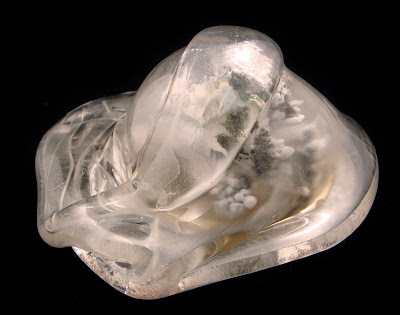Each of these exchanges include an image of what was taken, an image of what was left behind, and what the exchanger wrote on their survey:

Please describe the object you took:
small, white, with fluffy, springy feather looking thing inside
Please describe the object you left behind:
OLD key. Worn it around my neck for a year or so. I had little luck finding the knock it opens, maybe you will find it.
How did you determine that the object you left behind was of equal or greater worth than the object you took?
Objects are objects. In a million years, most of them will be gone or broken. I really liked having the hey necklace, but I must remember to let material things be material things ie: go away, get lost, be stolen, traded, given with love...
What will you do with the object you have taken?
Put it in sunlight & watch rainbows bounce around on my walls then give it away
Comments: Thanks for not taking everything to New York and selling them for lots of $$$. You've inspired Nelson!

Please describe the object you took:
Serene one altered deer.
Please describe the object you left behind: Sticker of a cat woman, a drawing I did.
How did you determine that the object you left behind was of equal or greater worth than the object you took?
One animal for another, sharing the animal kingdom
What will you do with the object you have taken?
Place in a pot with a plant.
Comments: Thank you for an amazing show.
The little people will be happy.

Please describe the object you took:
Shrcom [sic] Ville Ice Palace.
Please describe the object you left behind:
4x prints of my paintings with magnetic backing
How did you determine that the object you left behind was of equal or greater worth than the object you took?
I went with the feeling I had when I saw this particular piece & choose paintings that created a similar feeling for me in their making. value = feeling (rather than value = $).
What will you do with the object you have taken?
I will put it on my alter [sic]
Comments:
Thank you for thinking outside the box & creating alternative vessels for our thoughts.

Please describe the object you took:
It's a small punch glass turned over a dinosaur salted.
Please describe the object you left behind:
A 1960's GOBO made by the Toronto Sculpta [sic] Michael Hayden.
How did you determine that the object you left behind was of equal or greater worth than the object you took?
It is a rare cut out of a city landscape used in sixties light shows.
What will you do with the object you have taken?
Save cherish- perhaps gift to my son.
Comments:

Please describe the object you took: grey glass [Note- this was not descriptive enough for me to pair it with its traded object]
Please describe the object you left behind: copper pipe
How did you determine that the object you left behind was of equal or greater worth than the object you took?
it's what I brought
What will you do with the object you have taken? look at it
Comments:

Please describe the object you took: Very scary rooster figurine in a collapsed mason jar.
Please describe the object you left behind: A box I made out of fir scraps with dog shapes sprayed on it. Inside the box is a bird head of painted plaster I made.
How did you determine that the object you left behind was of equal or greater worth than the object you took?
There were similarities of scale, made from discards, sculptural, an object in a container, bird imagery and slightly morbid.
What will you do with the object you have taken?
I will display it in my bedroom on the dresser with my prosthetic ear and burning mattress painting. It belongs there.
Comments: Thanks for the opportunity

Please describe the object you took:
black origami
Please describe the object you left behind:
handmade alpaca & merino wool mittens-- mostly pink
How did you determine that the object you left behind was of equal or greater worth than the object you took?
well it's about sensation. Looking at ART really make [sic] me feel happy and warmer in my chest. Just like a pair of mittens could warm you up. Also, this exhibit has a "double" effect, it creates a 2nd exhibit of what people left in exchange. Double exhibit = double mittens!
What will you do with the object you have taken?
talk about it
Comments:
I wish the artist the awesomest rummaging among left behind stuffs. Thank you!

Please describe the object you took:
Piece with freeway. Somewhat obscured glass- I like that I have to find the image.
Please describe the object you left behind:
"big locket for a small world" or "super conductor for a small world" with maps of Nelson and NY and other found objects
How did you determine that the object you left behind was of equal or greater worth than the object you took?
I collected and found the various aspects and then assembled them- hoping to reflect or respond to the found object concept-- transform trash into treasure. Also responding to place-- maps of where max is "located"-- here and there with the idea of holding the tension of places and homes so different inside one self and being the conductor.
What will you do with the object you have taken?
Observe it.
Comments:
Thought-provoking, stimulating, clever, subversive & very excellently crafted. Lovely work. Thanks for coming. N.
















































